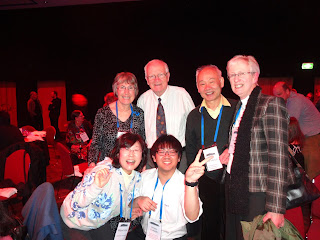Well, on August 1, 2015, my lab
members and I under the guidance of Sensei took an excursion to Akinada Island,
the connection between Japan and Korea in the long history. We left IDEC at
9:00 AM and we arrived at the target place of the excursion around one hour. Interestingly, along the road on both right
and left sides, we were very happy that we distracted our feelings with the
beautiful and lively landscapes. We also saw rice fields which grew naturally
and quickly because they had enough fertility and water under the control of
their farmers who took care of them carefully, daily, weekly, and monthly.
Whereas the mountains looked very beautiful and lively because they were filled
in all types of the thick trees, which were conserved by the local authority as
well as the government.
More interestingly, we came
across the long beautiful bridge, which is about 500 meters long. Through the
bridge, I could see many overviews such as cloud, many small islands, and
mountains around the sea. Following that long bridge, we also passed through
several bridges, but they are not so long as the previous one. However, they
are as pretty as the long one and they provided many scenes as well. We saw
many boats and ships that some of them were driving and some were parking at
the harbours.
While tasting and distracting the
landscapes along the roads, we immediately arrived at the place we planned to
visit. Firstly, we visited the national and historical parks on the sea sides
with beautiful aspects from the seas. At the entrance of the parks, we were
checked by the park authority there for the students’ identity cards.
Fortunately, international students were free for visiting all parks, called
Shoutouen, and long historical temples there.
The first temple contained many
potteries, which were originally made by Japanese 300 or 400 years ago. We were
very interesting when we entered the tea room. It was designed in a protocol
way for the people when they had discussion with relaxing and drinking tea. At
the corner room of that temple, we got beautiful landscapes from that room.
The second temple was Korean,
which was new because it was just recently built. It was designed for both
national and international delegates and it was treated as like the restaurant.
Therefore, there were many kinds of special food, which were very expensive
because they were prepared for dignitary people both local and international
guests. In that temple, there were many ships and many ceremonies that they
celebrated by carrying their emperor or delegate by poles. More interestingly,
one picture showed that Korean people celebrated their ceremonies with
Japanese, standing at the opposite corners and Korean accompanied their emperor
in the middle. This meant Japanese treated them kindly and carefully.
The third temple interested us
altogether; especially for international students, we saw performance scene
closed to the sea. The emperor saw the performance from the temple and judged
their performance, providing the satisfied present.
The forth temple was about the
potteries again. Most of them were brought from Europe 300, 400, or 500 years
ago. They were colourful and expensive with many designed patterns. I was very interesting when I saw the
European lamp because it looked modern even though it was built hundred years
ago.
The final temple we visited was
about how we produced wine and rice. We saw basin water and device to produce
the tasteful and famous wine in Japan. I also saw the round rice miller and the
rice miller for pedalling.
Finally, we left the temple for the beautiful mountain. We were happy with fear.
We were fearful because the car road was around the sea, the valley, and the hill of the mountain. We went up and down the hill and the road was curved and narrow. More terrifyingly, we got lost and we just went straight forward. Happily speaking, we were fortunately called back by Sensei’s car. I really appreciated Fukuda San, who drove carefully with high sense of caution. Finally, we met Sensei safely at the beautiful and lovely peak of the mountain because it looked like paradise that I have never seen such nice landscapes. From that view, we could sightsee the environment that was good-looking and so nice around that area. By looking down, we saw the citizens’ houses and the oranges between the sea and the mountain. The oranges were very famous not only for locality, but also for the whole country of Japan.
After that, it was time to have lunch. We left that mountain for Wakisakaya to have
lunch there. Wakisakaya was a famous restaurant because whoever visited there had lunch. They served many kinds of food like seafood, fishes, and so on. Moreover, we were free with a glass of lemon tea, which was very nice. The lunch time took us around 50 minutes.
The third historical and remarkable place that I could not forget was the town
Osakishimomijima Miterai. Therefore, after having lunch, we immediately went to visit the tower, which was built into the sea. We distracted the sea water levels and we were windy. Closed to that, there was a house, which was built for the God of the sea, called Srung. We visited many buildings and houses, which represented their own histories, respectively. We interestingly visited the famous clock watch around the world because all broken watches around the world were sent to be repaired there. The shop was so interesting with many brands of watches and the owners looked friendly and helpful. Finally, we went to the house of the God of study. Whoever wanted to be good at studying all types of subjects had to wish there. Most of us prayed for being good at study, including me as well.










